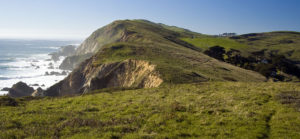People travel from around the world to visit the America’s National Parks. They come for the scenery, the wildlife, the human history.
But rarely–whether they’re visiting Muir Woods or the Everglades–do they come to sample the local, seasonal foods of whatever region they’re visiting. Instead they usually find the same fare available at most any shopping mall food court. That may soon change soon thanks to work being done at the Golden Gate National Recreation Area (GGNRA) and the Institute at the Golden Gate.
The institute’s “Food for the Parks” initiative aims to make GGNRA a model for national parks across the country to begin providing local, seasonal foods in the park system’s many eateries.
On November 7, environmental writer and thinker Bill McKibben, GGNRA’s Acting Deputy Superintendent Aaron Roth, and local chef/food activist Larry Bain gathered at Mission Blue Chapel at Cavallo Point in Marin to discuss the proposal and the role food could play in the future of the park system.
A self-proclaimed “rainer on parades,” McKibben was in unusually high spirits as he, Roth, and Bain discussed the success of the local food movement. “Our relationship with food is headed unambiguously in the right direction,” he said. “The degree to which local, seasonal food has taken off is astonishing.”
The Bay Area is very well aware of this, as farmer’s markets abound on all sides of the Bay, and prime agricultural land can be found nearby in every direction, with a good chunk of the harvest landing on Bay Area tables.
And a fair bit of that harvest also lands at GGNRA’s concessions. “The menu at Muir Woods is 77 percent local, coming from within 80 miles,” Roth said. “Of the produce and protein, 90 percent is local and 75 percent is organic.” And more than three quarters of the food waste from Muir Woods is diverted to local composting programs.
“We need to get closer to the real world,” McKibben says, “food is one of the easiest ways to do this.” Eating food that is local and in season serves to enrich the park experience, allowing visitors to further immerse themselves in the local region.
GGNRA’s accomplishments may be tough to replicate throughout the park system. The obstacles, while daunting, aren’t insurmountable, says Bain. “People have lived locally all around the world for many years,” he adds. “Only recently has it become an issue.”
In addition to providing park visitors with local, healthy and tasty foods, “Food for the Parks” could serve to bolster regional food system as parks make large purchases of local produce.
With “Food for the Parks” promising ecological sustainability, economic benefits, and a more solid sense of place in America’s national parks, it seems likely more local food will start popping up on park menus across the nation. But the final selling point is, of course, taste. “Thank goodness what we’re selling is delicious,” Bain says, “otherwise we’d need billions in advertising.”

.jpg)



-300x221.jpg)